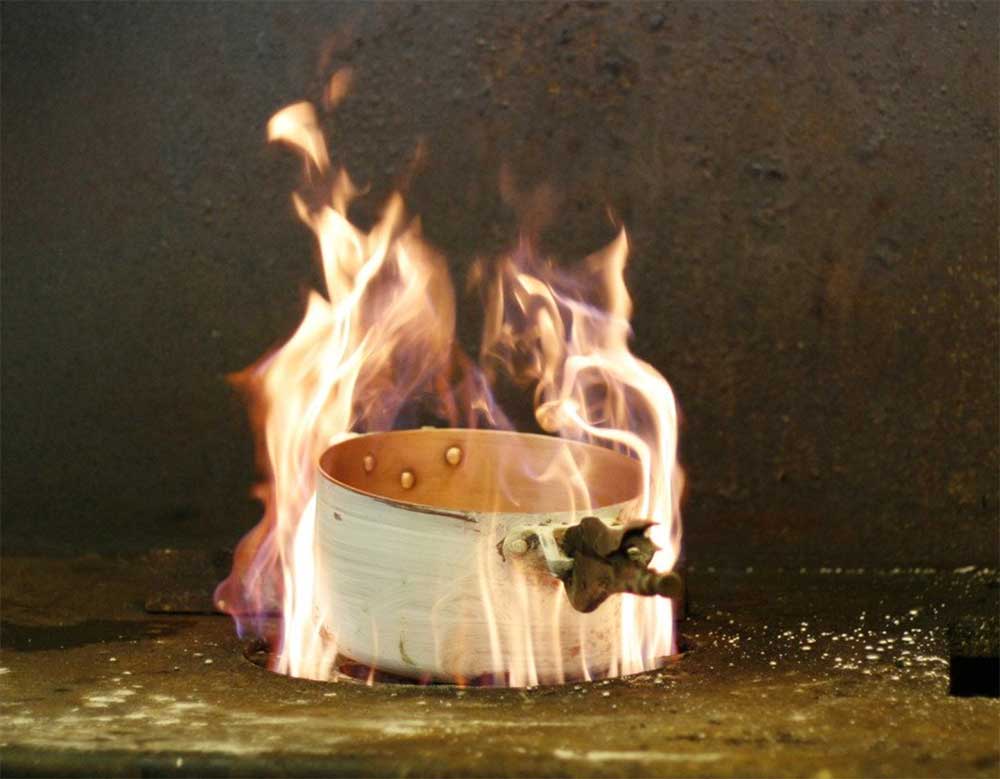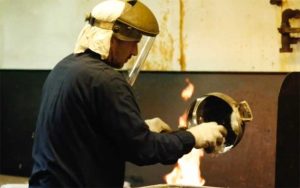
03 Nov Trial by Fire
 Tinning copper by the hand wiping method is an increasingly rare skill, and somewhat unique in that it has almost no potential to ever become automated — demand is limited (but not small), and as in any dance, timing and touch are key to pleasurable results.
Tinning copper by the hand wiping method is an increasingly rare skill, and somewhat unique in that it has almost no potential to ever become automated — demand is limited (but not small), and as in any dance, timing and touch are key to pleasurable results.
The first step in the tinning process is to dip the copper piece in an acid bath to remove oxidation that can’t be seen. Then the piece is water rinsed, scrubbed and dried. A thin mask of whiting (a paste of garden lime) is laid up over the exterior to prevent molten tin from adhering where it’s not wanted, and then we’re ready for the fun part.
The piece is heated over an open forge to over 600℉. Everyone knows copper heats quickly, but it cools just as quickly so we have to get the pan body well up over the melting point of tin to make sure the tin keeps flowing through the entire process. The unmasked, etched interior is then sprayed with a liquid flux and allowed to brown, ridding the surface of any residual surface oxygen and ensuring that the tin and copper bond directly.
 Some tinners use molten tin served from a ladle, and others prefer the “block” method of tossing bits of solid tin into the hot copper. Either way, once there’s liquified tin in the pot, time is short. While the pot is still in a more-or-less uniform temperature, the tin needs to be wiped evenly to cover the entire interior. On a large piece, such as a stock pot, this takes speed and steadiness because the pot is cooling as I work the tin with either cotton batting or glass insulation (the latter is best on very old, pitted, battered and irregular pieces with lots of nooks and crannies). When I’m up to my armpit in super-heated metal, speed and steadiness are critical for more than one reason!
Some tinners use molten tin served from a ladle, and others prefer the “block” method of tossing bits of solid tin into the hot copper. Either way, once there’s liquified tin in the pot, time is short. While the pot is still in a more-or-less uniform temperature, the tin needs to be wiped evenly to cover the entire interior. On a large piece, such as a stock pot, this takes speed and steadiness because the pot is cooling as I work the tin with either cotton batting or glass insulation (the latter is best on very old, pitted, battered and irregular pieces with lots of nooks and crannies). When I’m up to my armpit in super-heated metal, speed and steadiness are critical for more than one reason!
“Fine wipe marks in a finished, cured tin lining reveal the skill and speed of the tin smith.”
 Fine wipe marks in a finished, cured tin lining reveal the skill of the tin smith. Short wipes with interruptions in their paths show tentativeness and the possibility that the piece was not tinned in one complete pass — lots of short wipes allow the copper to cool too much. Reheating a partially tinned copper piece threatens to damage the bond under the tin already applied, so it’s best to finish the pan all at once. Long, smooth wipes allow complete coverage and afford enough time to make small adjustments while the piece is still hot enough.
Fine wipe marks in a finished, cured tin lining reveal the skill of the tin smith. Short wipes with interruptions in their paths show tentativeness and the possibility that the piece was not tinned in one complete pass — lots of short wipes allow the copper to cool too much. Reheating a partially tinned copper piece threatens to damage the bond under the tin already applied, so it’s best to finish the pan all at once. Long, smooth wipes allow complete coverage and afford enough time to make small adjustments while the piece is still hot enough.
Once I’m happy with the quality of the lining, depending on the piece it can then be let air cured or quenched in water. Water quenching can slightly anneal the copper (which helps solidify the tin bond), but if the just-set tin remains exposed to water it can “frost”, or take a cloudy cast. Still warm, the piece is dunked in sawdust to absorb residual water vapor I can’t see.
 The cooled pan is then scrubbed free of its lime mask and any flux residue. Once completely dried, the piece moves onto the polishing stage. The interior looks shiny-new, and now it’s time to polish the exterior back up to showroom quality, but that may be the subject of another article!
The cooled pan is then scrubbed free of its lime mask and any flux residue. Once completely dried, the piece moves onto the polishing stage. The interior looks shiny-new, and now it’s time to polish the exterior back up to showroom quality, but that may be the subject of another article!
Daniel K. Moore
Master Tinsmith

